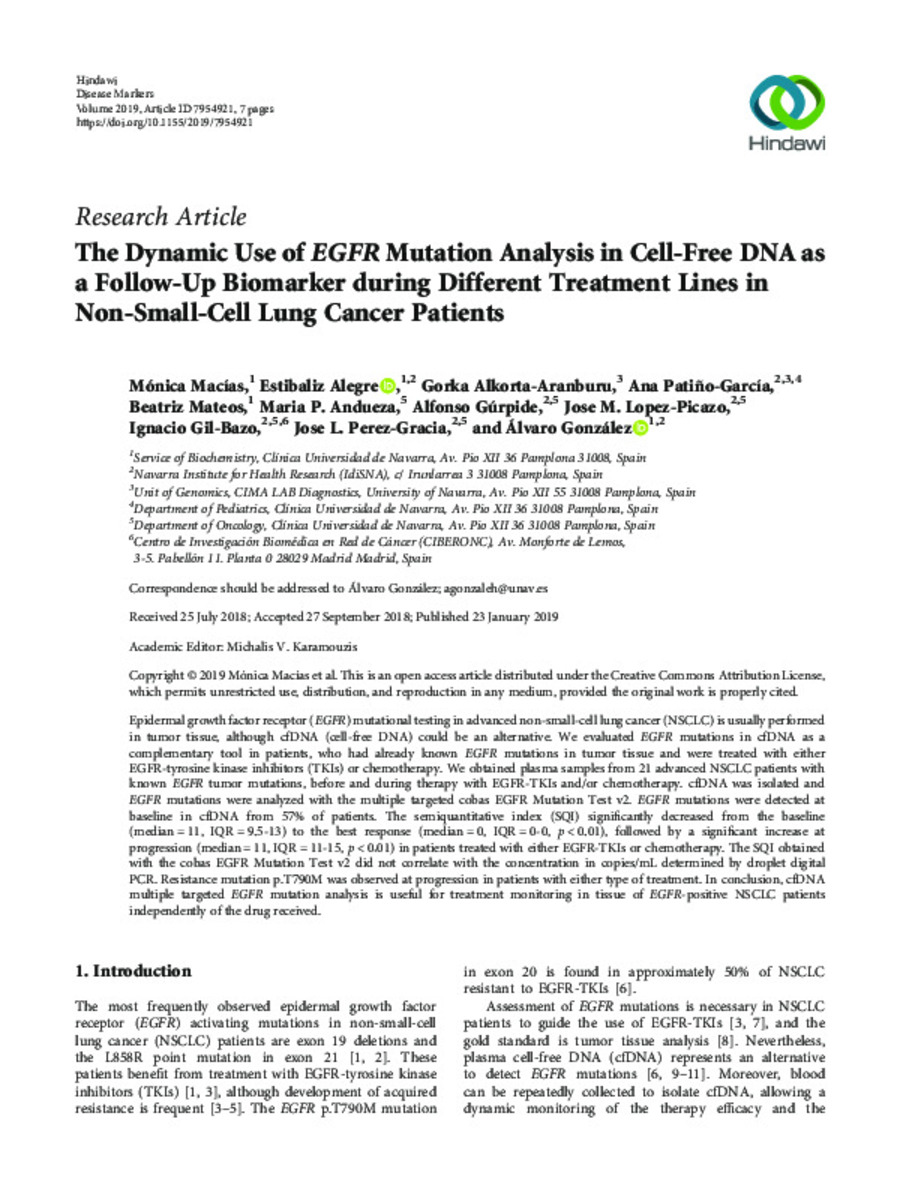Full metadata record
| DC Field | Value | Language |
|---|---|---|
| dc.creator | Macías, M. (Mónica) | - |
| dc.creator | Alegre-Martinez, E. (Estibaliz) | - |
| dc.creator | Alkorta-Aranburu, G. (Gorka) | - |
| dc.creator | Patiño-García, A. (Ana) | - |
| dc.creator | Mateos, B. (Beatriz) | - |
| dc.creator | Andueza, M.P. (Maria P.) | - |
| dc.creator | Gurpide, A. (Alfonso) | - |
| dc.creator | Lopez-Picazo, J.M. (José M.) | - |
| dc.creator | Gil-Bazo, I. (Ignacio) | - |
| dc.creator | Perez-Gracia, J.L. (Jose Luis) | - |
| dc.creator | González, Á. (Álvaro) | - |
| dc.date.accessioned | 2022-03-11T12:27:45Z | - |
| dc.date.available | 2022-03-11T12:27:45Z | - |
| dc.date.issued | 2019 | - |
| dc.identifier.citation | Macías, M. (Mónica); Alegre-Martinez, E. (Estibaliz); Alkorta-Aranburu, G. (Gorka); et al. "The dynamic use of EGFR mutation analysis in cell-free DNA as a follow-up biomarker during different treatment lines in non-small-cell lung cancer patients". Disease Markers. 2019, 2019, 7954921 | es |
| dc.identifier.issn | 0278-0240 | - |
| dc.identifier.uri | https://hdl.handle.net/10171/63141 | - |
| dc.description.abstract | Epidermal growth factor receptor (EGFR) mutational testing in advanced non-small-cell lung cancer (NSCLC) is usually performed in tumor tissue, although cfDNA (cell-free DNA) could be an alternative. We evaluated EGFR mutations in cfDNA as a complementary tool in patients, who had already known EGFR mutations in tumor tissue and were treated with either EGFR-tyrosine kinase inhibitors (TKIs) or chemotherapy. We obtained plasma samples from 21 advanced NSCLC patients with known EGFR tumor mutations, before and during therapy with EGFR-TKIs and/or chemotherapy. cfDNA was isolated and EGFR mutations were analyzed with the multiple targeted cobas EGFR Mutation Test v2. EGFR mutations were detected at baseline in cfDNA from 57% of patients. The semiquantitative index (SQI) significantly decreased from the baseline (median = 11, IQR = 9 5-13) to the best response (median = 0, IQR = 0-0, p < 0 01), followed by a significant increase at progression (median = 11, IQR = 11-15, p < 0 01) in patients treated with either EGFR-TKIs or chemotherapy. The SQI obtained with the cobas EGFR Mutation Test v2 did not correlate with the concentration in copies/mL determined by droplet digital PCR. Resistance mutation p.T790M was observed at progression in patients with either type of treatment. In conclusion, cfDNA multiple targeted EGFR mutation analysis is useful for treatment monitoring in tissue of EGFR-positive NSCLC patients independently of the drug received. | es_ES |
| dc.description.sponsorship | This work was supported in part by Roche Diagnostics and DIANA grants. | es_ES |
| dc.language.iso | eng | es_ES |
| dc.publisher | Hindawi Limited | es_ES |
| dc.rights | info:eu-repo/semantics/openAccess | es_ES |
| dc.subject | Epidermal growth factor receptor (EGFR) | es_ES |
| dc.subject | Non-small-cell lung cancer (NSCLC | es_ES |
| dc.subject | Cell-free DNA | es_ES |
| dc.title | The dynamic use of EGFR mutation analysis in cell-free DNA as a follow-up biomarker during different treatment lines in non-small-cell lung cancer patients | es_ES |
| dc.type | info:eu-repo/semantics/article | es_ES |
| dc.description.note | This is an open access article distributed under the Creative Commons Attribution License, which permits unrestricted use, distribution, and reproduction in any medium, provided the original work is properly cited. | es_ES |
| dc.identifier.doi | 10.1155/2019/7954921 | - |
| dadun.citation.publicationName | Disease Markers | es_ES |
| dadun.citation.startingPage | 7954921 | es_ES |
| dadun.citation.volume | 2019 | es_ES |
Files in This Item:
Statistics and impact
Items in Dadun are protected by copyright, with all rights reserved, unless otherwise indicated.






